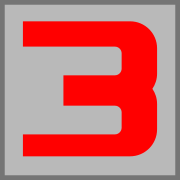Minesweeper/Playing The Game
Minesweeper mostly consists of thinking and a little bit of luck. Though it is not a game of quick reflexes or action, players may find themselves making suspenseful decisions when executing an uncertain move.
Basics of Play
[edit | edit source]Note that these instructions are written with the built in Minesweeper that is included with Microsoft Windows, and specific instructions, such as right clicking may not be universal among clones of the game or among games inspired by it. |

Minesweeper starts off with a blank board of tiles. The default is 9x9, but it can be any size. Each tile can be in three main states:
- It can be blank, with no information. (These are tiles that haven't been clicked on)
- It can have a number or remain blank.
- The number shows= how many mines are in the 8 tiles surrounding it.)
- It can be blank after clicking on it. This is effectively a number tile with the value of 0, indicating there are zero mines around it.
- It can be a bomb.
Example Game
[edit | edit source]You start off with a blank grid, and for your first tile, you must guess.
Here's an example below, of a 4x4 grid:
 |
 |
 |

|
 |
 |
 |

|
 |
 |
 |

|
 |
 |
 |

|
Now let's say, you clicked on the tile at (2,2)
 |
 |
 |

|
 |
 |
 |

|
 |
 |
 |

|
 |
 |
 |

|
That would tell us, "1" of the 8 tiles around it are a mine. Let's try clicking on two more:
 |
 |
 |

|
 |
 |
 |

|
 |
 |
 |

|
 |
 |
 |

|
We can tell that the tile in the top left corner has a mine, because it has to be a tile shared by all three ones. To illustrate this (? means possible mine):
 |
 |
 |

|
 |
 |
 |

|
 |
 |
 |

|
 |
 |
 |

|
Only one "X" is shared by all three ones, therefore, that must be our mine. Now that we know it's a mine, we can indicate that by right clicking on it. Right clicking on a tile will make it through a few of its states. The first one, would "flag" it, with a small red flag. The second, will replace the flag with a question mark (Shown above). And a third click would make it revert back to it's original state (as a blank tile).
 |
 |
 |

|
 |
 |
 |

|
 |
 |
 |

|
 |
 |
 |

|
The Tiles
[edit | edit source]Blank Tiles
[edit | edit source]The blank tiles show nothing on them. They can be hiding a number tile or a mine tile under them. A flag tile can also be played on it. In some versions of the game, there are also question mark tiles, which can also be played on blank tiles.
Number Tiles
[edit | edit source]The number tiles can have a number from 1 to 8. The numbers tell how many mine tiles are touching the number tile.
In some versions of the game, number tiles come in many colors, making it easier to distinguish them at a glance.
Mine Tiles
[edit | edit source]The mine tiles shows a mine on each one of them. When the player clicks on a Mine tile, then they loose the game.
Flag Tiles
[edit | edit source]The flag tiles shows a flag on them. These tiles can still be clicked on if the flag is taken off. The player can choose where to put the flags. The flags shows your guess on where the mine is, but the game will not stop the player from placing a flag where there is no actual mine. Because of this, it is a good idea to only use a flag when you are certain there is actually a mine. If you simply suspect a mine, a question mark is often a better representation of that uncertainty.
Question Mark Tiles
[edit | edit source]The Question mark tiles show a question mark on them. Only some versions of Minesweeper are equipped with this feature. This tile can be clicked on if the question mark is taken off. The player can choose where to put the question mark. The question mark shows where the player isn't sure what is under the blank tiles. When a player is certain a mine is beneath a tile, it is better to use a flag tile instead.
Mine Free Tiles
[edit | edit source]Mine free tiles have no picture on them, but have been clicked on. Distinguishing them from number tiles, this tile indicates that there are no mines around them.
-
Depiction of an unoppened tile.
-
Depiction of a 3 number tile.
-
Depiction of a mine from the game Gnomine.
-
Depiction of a flag tile
-
Depiction of a Question Mark tile




